With even limited space it is possible to grow a medicinal garden capable of taking care of most common illnesses and problems.
Most of these plants do best with room to spread out, but you can grow them in smaller spaces or even in pots. As a bonus, they are attractive plants that can double as a flower garden.
Most of these are easily used as a dried herb or brewed into a tea. You’ll find that they work just as well as the pharmaceutical drugs you currently use.
Chicory – Cichorium Intybus
Chicory is often grown for use as a coffee substitute and that alone is a good reason to have it in your garden.
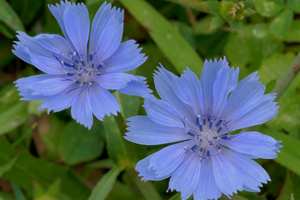
However, chicory is a valuable medicinal plant that can be used as a tea to treat liver and gallbladder disorders, jaundice, and enlargement of the spleen. It is also useful for digestive problems.
Related: This Driveway Weed Has Pain-Killing Properties Similar to Ibuprofen
A poultice of crushed leaves treats skin eruptions, swellings, bruises, and inflammations.
Additionally, the milky juice from a fresh root has the properties of a mild sedative.
Yarrow – Achillea Millefolium
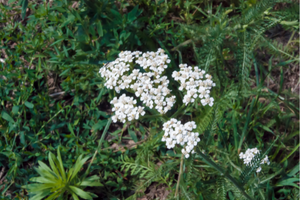
It grows well in temperate regions across the US. The leaves are edible and quite good in salads when picked young.
Yarrow is a good, all-purpose medicine with any uses. All parts of Yarrow are medically active.
Related: $0 Alternatives to Pain Meds
It contracts the blood vessels and quickly stops bleeding when applied as a poultice to the wound. It stops the bleeding and helps the wound heal.
The oil is useful for treating nosebleeds and minor injuries. Taken orally, yarrow is effective for treating diarrhea, gas, and other stomach problems.
It is also useful for asthma, colds, runny noses, arthritis, and liver problems.
California Poppy – Eschscholzia Californica
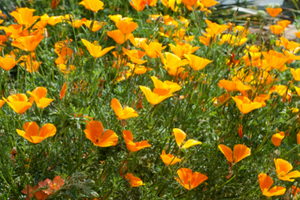 Also known as the golden poppy, the California poppy has a limited growing range, but if it will grow in your area, it is worth the space in your medicinal garden.
Also known as the golden poppy, the California poppy has a limited growing range, but if it will grow in your area, it is worth the space in your medicinal garden.
It is native to the western US and grows in coastal and desert regions and in foothills and valleys.
The California poppy has sedative properties, but it is not psychoactive like other members of the family.
The watery sap is a mild narcotic and is useful for pain relief. It does induce sleepiness and has an effect similar to the opium poppy, only milder, and it does not depress the central nervous system.
It calms the spirit and helps treat psychological problems. It is also useful for treating insomnia, nervous agitation, and promoting relaxation.
A wash made from the roots of the California poppy also suppresses the milk in nursing mothers. Wash the breasts with the tea to dry up milk flow quickly.
Peppermint – Mentha Piperita
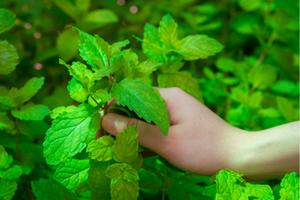 Peppermint is an excellent choice for your medicinal garden because of its use with stomach problems and muscle relaxation.
Peppermint is an excellent choice for your medicinal garden because of its use with stomach problems and muscle relaxation.
However, there are many mints available at your local nursery and not all have the same properties, so make sure you get mentha piperita.
Use peppermint tea to treat gastroenteritis, irritable bowel, Crohn’s disease, indigestion, flatulence, intestinal, and liver problems.
Related: Make Your Own Peppermint Oil – The Best Insect Repellent
Peppermint relaxes muscle spasms that cause stomach upsets. These relaxing properties also work to relieve headaches and migraines. Drink the tea and rub peppermint oil on the forehead over the affected area.
Rubbing peppermint leaves on the skin slightly numbs the area and relieves pain from insect stings, itching, and mild skin irritation.
It also has anti-bacterial and anti-viral properties and it promotes skin healing.
Chamomile – Matricaria Chamomilla
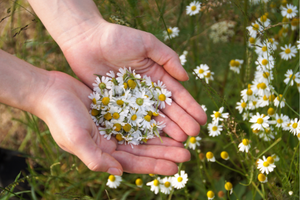 Chamomile is another easy to grow plant for your medicinal garden. The German variety, Matricaria chamomilla, is the best variety for medicinal use.
Chamomile is another easy to grow plant for your medicinal garden. The German variety, Matricaria chamomilla, is the best variety for medicinal use.
For most applications, chamomile tea is the delivery method of choice, but it can also be taken as a supplement, tincture, or essential oil.
Chamomile relaxes the muscles, making it a good treatment for abdominal pain, indigestion, Crohn’s disease, irritable bowel syndrome, gastritis, bloating, and muscle tension.
It is safe to use in small doses with babies suffering from colic.
The anti-spasm properties are also useful for treating asthma, bronchitis, whopping cough, and congestion. A cup of chamomile tea at night is soothing and helps induce sleep.
Apply chamomile tea as a wash for skin problems, eczema, itching, and allergic conditions. Use it as an eyewash diluted in cooled, boiled water.
Evening Primrose – Oenothera Biennis
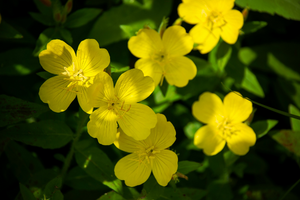 Evening primrose is a biennial, herbaceous plant.
Evening primrose is a biennial, herbaceous plant.
Sow seeds in the late winter or early spring in USDA growing zones 3-8.
Evening primrose is useful for balancing the hormones and treating hormonal problems in both men and women.
It also treats skin problems such as acne, eczema, psoriasis, and atopic dermatitis, reducing inflammation and promoting healing.
Because evening primrose reduces inflammation, it is useful in treating inflammatory problems such as arthritis and osteoporosis. It also balances the hormones that cause bone loss and increases bone density.
The bark and leaves of evening primrose are astringent, sedative, and healing.
They are useful for treating gastro-intestinal disorders, whooping cough, and asthma.
Regular consumption of evening primrose helps reduce blood cholesterol and lowers blood pressure with long term use.
Meadowsweet – Filipendula Ulmaria
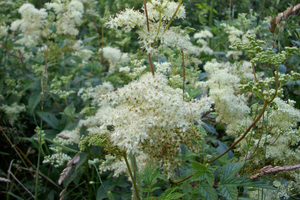 Meadowsweet is a beautiful and fragrant plant. It grows well in partial shade and likes moist soil.
Meadowsweet is a beautiful and fragrant plant. It grows well in partial shade and likes moist soil.
Plant it in a well-draining location and mulch it well to hold in moisture.
Meadowsweet tea is an analgesic with properties similar to aspirin.
It relieves fevers and colds and treats pain due to digestive problems, inflamed joints, headaches, and other pain. The herb is a natural diuretic.
Meadowsweet is used as an astringent and skin conditioner by soaking the leaves in rainwater.
Echinacea – Echinaceae Purpurea
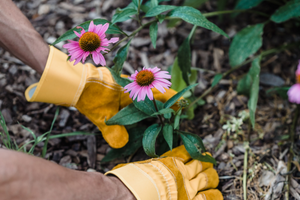 There are three Echinacea species which have medicinal uses: E. purpurea, E. angustifolia, and E. pallida. It prefers full sun to partial shade and well-drained soil.
There are three Echinacea species which have medicinal uses: E. purpurea, E. angustifolia, and E. pallida. It prefers full sun to partial shade and well-drained soil.
Start echinacea in the spring, late summer, or fall. It has long been used as a general “cure-all.”
It is used as a preventative and treatment for the flu, colds, and upper respiratory infections.
It is also useful for treating whooping cough (pertussis), candida and other fungal infections, tumors, and infections.
It boosts the immune system and has anti-viral, anti-bacterial, anti-fungal, and anti-inflammatory properties.
Calendula – Calendula Officinalis
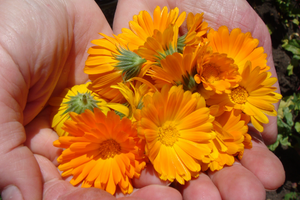 Also known as pot marigold, calendula is one of my favorite herbs.
Also known as pot marigold, calendula is one of my favorite herbs.
It is incredibly soothing for skin conditions including acne, eczema, sunburns, and rashes.
A poultice made from the leaves is healing for minor cuts, scratches, and skin irritations.
Both the leaves and flowers are useful and have anti-bacterial and anti-fungal properties.
Use calendula to treat fungal infections including ringworm, athlete’s foot, thrush, diaper rash, and cradle cap.
Calendula is useful for treating stomach and intestinal problems, including gastroenteritis, colitis, ulcers, and other stomach irritations.
Calendula stimulates the immune system and the lymphatic system. It helps the body fight off infections and viruses and reduces congestion and swelling in the lymph glands.
Calendula is also useful for whole-body detoxification. It helps cleanse the liver and gallbladder and is a good treatment for problems with these organs.
Feverfew – Tanacetum Parthenium
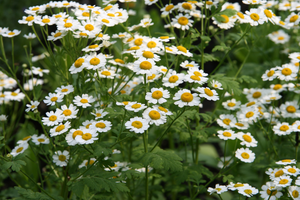 Also known as wild chamomile and bachelor’s buttons, feverfew is part of the sunflower family and is a perennial.
Also known as wild chamomile and bachelor’s buttons, feverfew is part of the sunflower family and is a perennial.
Feverfew leaves and flowering heads relieve the inflammation that causes arthritis pain.
The herb reduces the associated pain when taken regularly.
Generations of Europeans have relied on feverfew as a home remedy for reducing fevers and pain. It can be added to teas, or one can simply chew one of the leaves.
For localized arthritis pain or muscle pain, a poultice made from crushed feverfew leaves placed over the affective area is sufficient. It relieves the pain and calms the inflammation over the joint.
Crush some feverfew leaves (soak them if dried leaves are used) and place them directly over the joint. Cover with a clean cloth to hold them in place.
You may also like:
 Making and Using Thermite for Survival
Making and Using Thermite for Survival
10 Medical Supplies You Need To Stock Up Before It’s Too Late (Video)
Disaster Preparedness; Ahead of the Curve in a World of Dependence

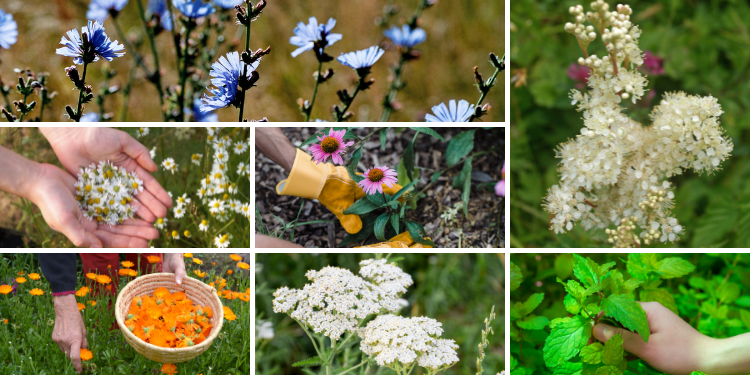













Thank you for making a well thought out article with a lot of details and helpful information. More articles should follow this format.
Your is very informative thanks
Where can you get seeds for these plants?
https://medicinalkit.com/?hop=globalbro&vendor=bookofren
Can anyone let me know what plants are best for attracting bees and where to buy them?
Thanks,
Ed
https://oldworldgardenfarms.com/2022/03/27/plant-marigolds-with-tomatoes/
good article on marigolds >>>>>
Phacelia is considered the best all-around late winter bloomer for bees. A native of the US southwest, it’s grown all over the world. But, while it doesn’t live long enough to become a weed, it has to have drought-like, low humidity conditions to reproduce.
Elm trees make a ton of nectar. Elm means bee. dandelions, chicory, crucifers that bolt. Seed pods from crucifers like radishes make a very good snack. niio
https://www.motherearthnews.com/organic-gardening/
Diane, good one!
Chicory: I’m called a master gardener because I can get it to grow here.
Yarrow does too well here and chokes out good, better things.
California Poppy I see I need to know more on this! They’re a great early summer flower.
Peppermint is an old favorite that I wish did well in the canyons. It’s foun up along moutain streams miles from us.
Chamomile always good to have on hand!
Evening Primrose does well in our zone 9. best bet is to find local varieties.
Echinacea is good here.
Calèndula! ‘tis the season to pick flower heads to dry. Winter production is allowed to go to seed, but spring/summer no. Most seed would die, anyway, or be carried off by harvester ants.
Feverfew: Like it and we’re stocked on it. Niio!
Dian: Most seed companies have a section on herbs. And, as well, a lot of these herbs has varieties that were bred to be ornamental. Foodwise, most American Indian food plants had to be pretty as well as tasty. Women owned the fields and the crops and were the ones who decided how to improve and continue plants. niio
Good article.
I think I will put more of these types of flowers around my house and then my wife will like those in her flower beds, then me putting my veggie’s in there.
She says the garden is mine not the flower beds. So now i will get these types for her. LOL.
See I still get my way. not often but sometimes…
red ant: Right now we’re picking and drying a lot of calendula. We let it self-sow over winter (pollen and seedlings are not likely to survive the heat, anyway). If looking for a few extra bucks, petals were bringing 16/oz years ago. No clue what they cost now. niio
so many look the same
Tried to enter my email for the medicinal book, but received the following message even when I tried to use a different email of mine.
Oops! It looks like there was an error: There was an error with your submission: Validation error: “Invalid Form Fields” Validation error: “Invalid Form Fields”